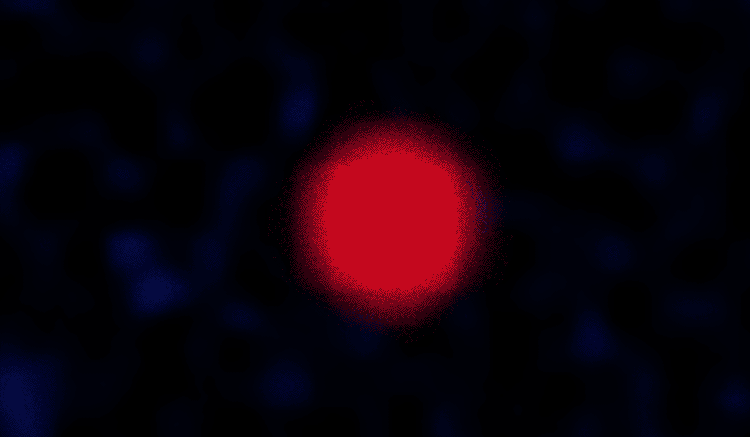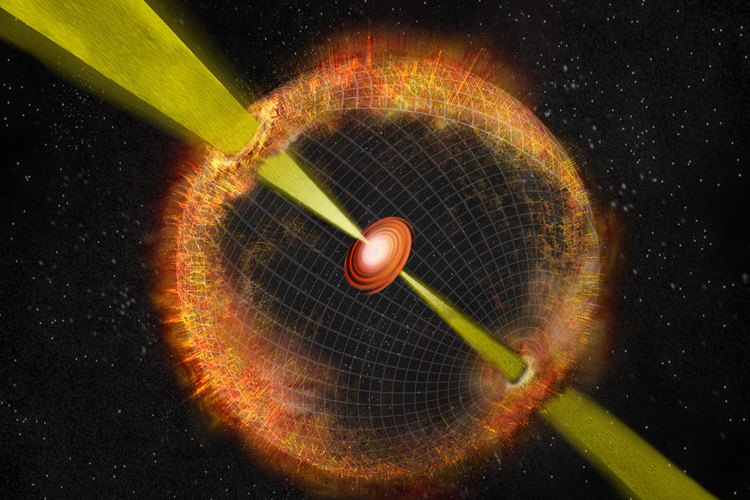
Astronomers typically study objects that are visible night after night or explode suddenly, like supernovas, but Casey Law is scouring vast amounts of data in search of bright objects that disappear, never to be seen again.
That search turned up the first of what may be many “ghost” objects in the sky: in this case, an extremely bright source of radio emissions that blazed into existence in the 1990s and then faded out over the next 25 years.
Based on the extreme brightness of the radio source and the type of galaxy in which the flare-up occurred, Law argues that it was the afterglow of the explosion of a massive star, which would have emitted an undetected long-duration gamma-ray burst. Gamma-ray bursts, whose origins are still contentious, are among the most intense flashes in the universe because much of their explosive energy is collimated into a tight beam, like that from a lighthouse.
“We believe we are the first to find evidence for gamma-ray bursts that could not be detected with a gamma-ray telescope,” said Law, an assistant research astronomer in the Department of Astronomy at the University of California, Berkeley. “These are known as ‘orphan’ gamma-ray bursts, and many more such orphan GRBs are expected in new radio surveys that are now underway.”
Gamma-ray bursts, such as that detected last year accompanying gravitational waves from the merger of two neutron stars, are rarely seen because the source of the gamma rays – a relativistic jet of material emerging from the explosive merger – must be pointing directly at Earth. Perhaps only one in 100 explosions can be seen from Earth by NASA’s Fermi Gamma-ray Space Telescope, for example.
The fact that these explosions are followed by a decades-long radio afterglow provides a way for astronomers to find the rest of these explosive events, not just those heralded by a gamma-ray burst.
Finding many more gamma-ray bursts will help resolve a major question in astronomy today: What are these massive stellar explosions that generate gamma-ray bursts, and what’s left behind afterward?
Law favors the theory that the explosion – whether preceded by the merger of two very large stars or neutron stars, or marking the death of a single, massive star – produces a rapidly spinning and highly magnetized neutron star, known as a magnetar. The surrounding matter emits intense radio waves that slowly fade away, during which time the magnetar spins down and occasionally emits fast radio bursts, another mysterious “transient” event in the universe.
He and his colleagues detail their observations and conclusions in an article recently accepted by the journal Astrophysical Journal Letters and accessible now on the arXiv server.
The value of archived data
The radio source (FIRST J141918.9+394036), now too faint to show up in sky surveys but still detectable by large radio telescopes, was a bright spot in a radio survey of the sky conducted in the early 1990s by the Very Large Array in New Mexico. It was on a par with the brightest radio sources in the universe: quasars and active galactic nuclei fueled by stars and gas falling into the massive black holes in the cores of galaxies.

“We thought, ‘That was weird,’” Law said. “Its peak brightness in the ‘90s was quite high, so it was a big, big change: about a factor of 50 decreases in brightness. We basically went through every radio survey, every radio dataset we could find, every archive in the world to piece together the story of what happened to this thing.”
He and his colleagues discovered 10 other sets of radio observations of that area of the sky, in the constellation Boötes, that allowed them to document the object’s appearance and disappearance.
They concluded that the radio emissions first reached Earth in 1992 or 1993, though their first detection was around the source’s peak brightness in 1994. It then faded away over a period of 23 years. It was fainter in a 2010 survey and barely visible in 2015. It was invisible in a 2017 Very Large Array Sky Survey.
The mystery object is located inside a dwarf galaxy 284 million light years from Earth that is still forming stars: a special environment that has previously been associated with fast radio bursts and, independently, gamma-ray bursts and the formation of magnetars. This led Law to conclude that the radio emissions from the dwarf galaxy were the 25-year-long afterglow from the explosion of a massive star, perhaps more than 40 times the mass of the sun, which would have produced a long gamma-ray burst that went undetected. Most GRBs last less than a minute.
One theory is that the resulting magnetar, because of its high rotation rate and huge magnetic fields, emits periodic fast radio bursts – each just a millisecond long – as it winds down to a run-of-the-mill pulsar.
While Law is enthused by the possibility of uncovering many more orphan gamma-ray bursts, he emphasizes the value of mining archived observational data in search of astronomical events that pop up and fade out over years to decades — what his team jokingly refers to as “anti-transients.”
“Part of the story is about how much of the sky is changing, even on this long time scale, and how hard it is to test that,” he said. “It is also partly about the value of new data science techniques. Pulling out information from these rich and diverse data sets is helping us do good science.”
Law’s co-authors are Bryan Gaensler of the University of Toronto’s Dunlap Institute, Brian Metzger and Lorenzo Sironi of Columbia University, and Eran Ofek of the Weizmann Institute in Israel. Law’s research is supported by the National Science Foundation (1611606).
Reference: “Discovery of the Luminous, Decades-Long, Extragalactic Radio Transient FIRST J141918.9+394036” by C. J. Law, B. M. Gaensler, B. D. Metzger, E. O. Ofek, and L. Sironi, 16 October 2018, The Astrophysical Journal Letters.
DOI: 10.3847/2041-8213/aae5f3
Never miss a breakthrough: Join the SciTechDaily newsletter.